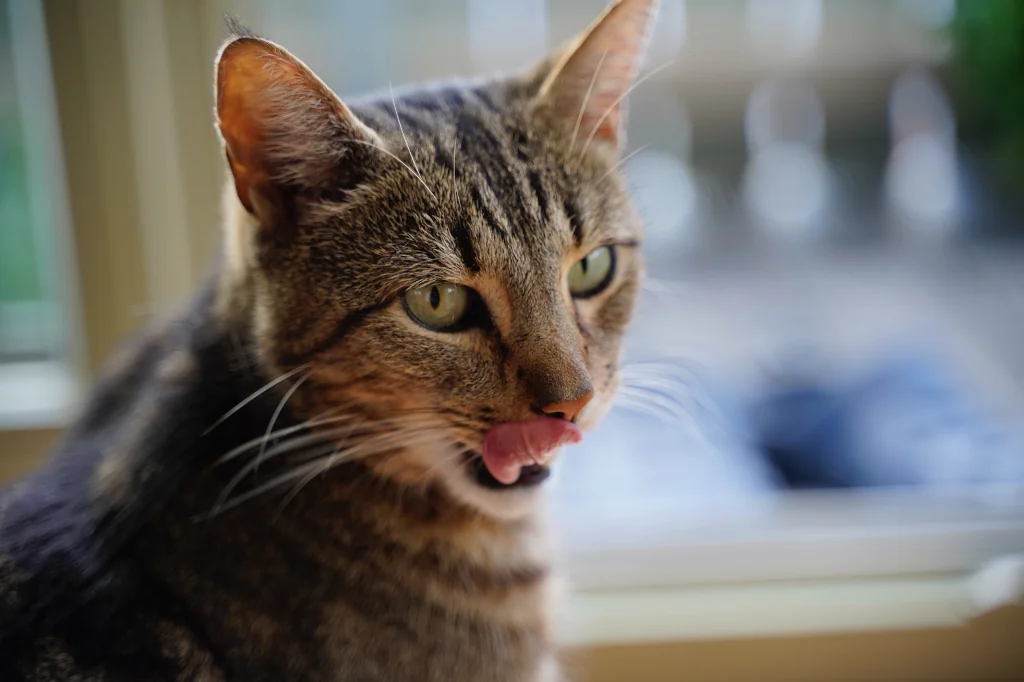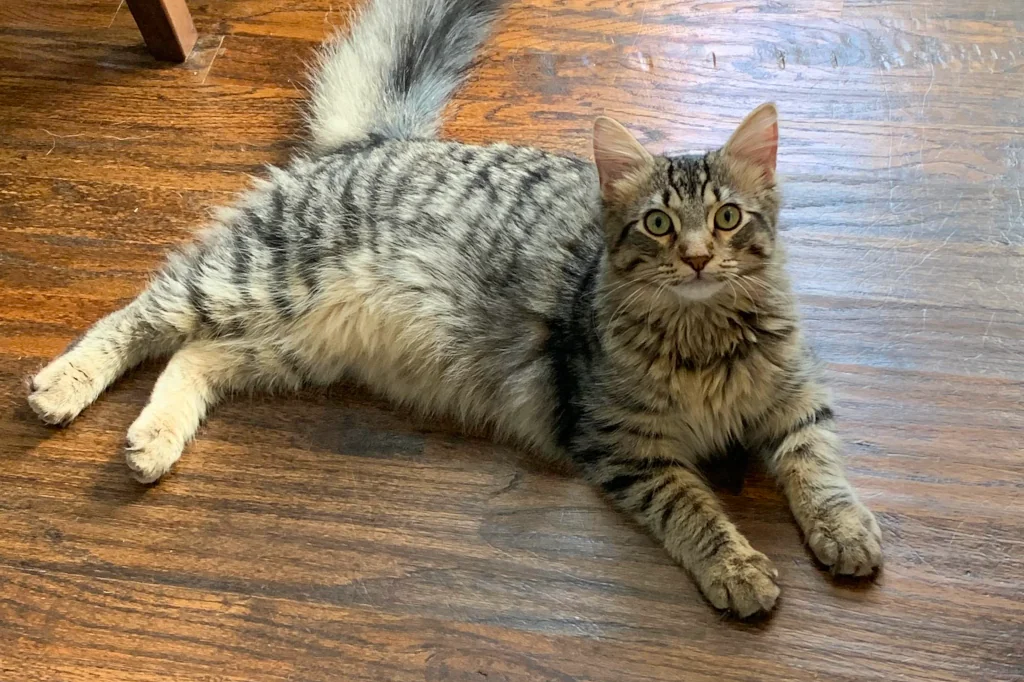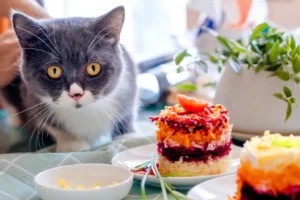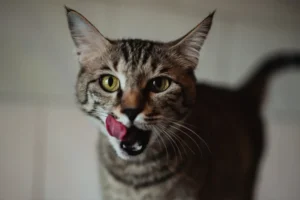Note: We may earn a commission from helpful, relevant links in our content. No cost to you. See our privacy policy.
Are you constantly doubting if your furry friend is getting enough to eat? This nagging worry is more common than you think.
Among the sea of online advice and cat food brands, it’s easy to lose sight of how much your cat really needs. We’ve all been there, counting each morsel and trying to match it with the breed, age, and lifestyle of our cat.
The good news is, we’ve done the homework for you. Buckle up, and let’s decode the mysteries of cat feeding together.

Signs of an Underfed Cat: What to Look For?
There’s no need for guesswork when it comes to identifying an underfed cat. Key signs will show up in your cat’s behavior, physical condition, and overall demeanor. If you’ve been worried about your feline friend not getting enough nutrients, here’s a concrete checklist to guide you:
- Weight Loss. Is your cat shedding pounds noticeably? If yes, this could be a sign of underfeeding. Remember, gradual changes can be hard to notice, so regular weight checks are important.
- Vocalization. Cats can get vocal about their hunger. If your kitty has turned more talkative, especially around meal times, it might be asking for more food.
- Lethargic Movements. Does your energetic furball now laze around more often? A decrease in energy levels can be a clear indication of undernutrition.
- Dull Coat. A lustrous, silky coat is a sign of good health. If your cat’s coat seems dull or lifeless, reassess its diet.
- Less Interest in Playtime. Cats enjoy their playtime, but underfed cats may show less interest, signaling an issue.
- Food-Related Anxiety. Underfed cats might develop anxiety around food, often gulping down meals quickly or acting protective over their food.
- Increased Aggression. Changes in behavior, such as increased aggression, can also be a sign of underfeeding. The stress from not getting enough food can make cats more irritable.
- Unusual Pica Behavior. Cats might start eating non-food items like fabric, plastic, or litter if they’re not getting enough nutrients from their diet.
Each cat is unique, and these signs can vary. But if you notice a combination of these, it’s time to reevaluate your feeding plan.
How Much Food Is Too Little for a Cat?
Knowing exactly how much to feed your cat can be tricky as it depends on a variety of factors – breed, age, weight, activity level, and even whether your cat is neutered.
However, a general guideline is that an average-sized adult cat requires about 20 calories per pound of body weight to maintain a healthy weight. So, for example, if your cat weighs 10 pounds, you’d be aiming for roughly 200 calories per day.
Once again, this is just a general guideline. To get a more accurate estimate, you might want to consult with your vet. They can help you create a feeding plan that’s just right for your cat’s unique needs.
Calculator for Cat’s Daily Calorie Needs
Estimate your cat’s daily calorie needs based on their weight using our simple calculator. Just enter your cat’s weight in pounds and click “Calculate”.
Enter your cat’s weight (in pounds):
🔔 Note: This calculator estimates the calorie needs of cats at a healthy weight. If your cat is overweight, feeding them based on their current weight could lead to overfeeding. Instead, use their target weight, which is the weight they would be at a healthy size.
Is Your Cat Always Hungry? How to Actually Tell
Cats, like us, have their quirks when it comes to food. Some might be seemingly insatiable, while others could be pickier.
However, distinguishing between a cat that’s genuinely hungry and one that’s just ‘food-bored’ can make all the difference.
Your cat may not be hungry if it tends to be interested in food only when a new can is opened but loses interest quickly. Another telling sign could be if your cat is primarily interested in ‘people’ food or treats and not its regular meals.
But here’s a golden nugget that most miss – watch for their eating speed. A hungry cat tends to eat quickly, consuming most, if not all, of the food in one sitting. On the other hand, a cat that isn’t truly hungry will often nibble a bit and then walk away, only to return later.

How to Tell if You’re Overfeeding a Cat?
Identifying overfeeding is equally crucial as noticing underfeeding.
Overfeeding can lead to obesity and associated health issues. If your cat is gaining weight, or if you notice it’s less active or having difficulty moving around, these could be signs of overfeeding.
However, weight gain isn’t the only symptom. Digestive issues such as constipation or diarrhea could also be a sign that your feline friend is eating too much.
Now, here’s a piece of advice that’s often overlooked but incredibly valuable: check your cat’s ribs. In a healthy, well-fed cat, you should be able to feel its ribs with a slight layer of fat over them. If the ribs are hard to feel or the stomach appears distended even when your cat hasn’t just eaten, it might be time to cut back on the portion sizes or reconsider the feeding schedule.
You can use this body condition score for pets to assess if your cat may be underfed:

A healthy cat should have a body condition score of around 4 to 5. You can check this for overwheight cats as well. Here’s more tips on body condition scoring. As always, your vet is your best resource for personalized advice.
What’s a Good Feeding Frequency for Cats?
The optimal feeding frequency for cats is often determined by their age and health status.
Kittens typically need small, frequent meals due to their rapid growth and high energy levels, so feeding them four times a day is usually recommended. For most adult cats, feeding them twice a day—morning and evening—works well.
Here’s an insider tip that some might not be aware of: free feeding, or leaving food out all day for the cat to graze, can lead to overeating and obesity, especially in less active, indoor cats. It’s generally better to have set meal times.
Recommended High-Nutrition Foods for Your Cat
The world of cat food can seem overwhelming, with so many brands and formulations to choose from. However, a few key aspects should guide your selection.
Choose foods that list a source of animal protein like chicken, beef, or fish as the first ingredient. Wet food is generally preferred over dry food as it provides additional hydration. Both have their merits, and the mix is usually recommended.
To read more about this, check our guide on dry vs wet cat food.
Now, a tip from my personal experience: Many cat owners overlook the nutritional value of organ meats like liver, which are packed with essential nutrients. Brands like Wellness CORE offer palatable pate-style wet foods featuring these nutritious ingredients.
Besides Wellness CORE, there are a few other brands that have impressed both me and many other cat owners, particularly when it comes to providing nutrition-dense meals that help with underfeeding issues. These include:
- Blue Buffalo Wilderness. Known for high-protein, grain-free cat food that mimics the diet of wild cats. Their formulas often contain a healthy mix of fruits, vegetables, and meat.
- Natural Balance. They offer limited-ingredient diets, which are great for cats with food sensitivities. This way, your cat gets the necessary nutrition without any unwanted side effects.
- Hill’s Science Diet. Hill’s is highly regarded for its scientific approach to pet nutrition. Their cat foods are specially formulated to address various health needs, including weight management, which could be crucial for underfed cats.
Remember to always gradually introduce new food into your cat’s diet to avoid upsetting their stomach.
Related: Choosing Wet Cat Food Guide
As we wrap up this guide, remember that your cat’s nutritional needs are as unique as they are. Tailor their diet to suit their age, lifestyle, and health status, keeping an eye out for signs of over or underfeeding.
Our feline friends rely on us for their well-being. While it might seem challenging at times, the purrs, headbumps, and contentment in their eyes make it all worth it. Happy feeding!
Related: How to Choose the Right Dry Cat Food
FAQs
Can my cat’s breed impact how much food it needs?
Different cat breeds can have varying energy levels and metabolic rates, which could influence the amount of food they require. For instance, active breeds like Siamese cats might need more food than less active breeds.
Do indoor and outdoor cats have different food requirements?
Outdoor cats generally have a higher activity level and may require more food or a diet higher in protein. Indoor cats, on the other hand, usually require a diet carefully calibrated to prevent weight gain due to their less active lifestyle.
Does a cat’s age influence its feeding schedule?
Indeed, a cat’s age significantly influences its feeding schedule. Kittens require multiple small meals a day due to their growth and energy needs, while adult cats typically do well with two meals a day. Senior cats might need dietary adjustments to accommodate health changes.
Alex, a passionate animal lover, has experience in training and understanding animal behavior. As a proud pet parent to two dogs and three cats, he founded AnimalReport.net to share insights from animal experts and expand his knowledge of the animal kingdom.









